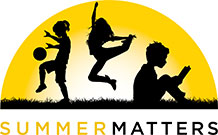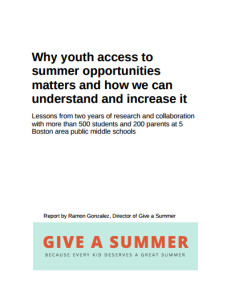Youth Access to Summer Opportunities at Boston Area Middle Schools
In-Depth Picture on Barriers to Summer Program Opportunities and How Schools and Communities Can Address Them
Give a Summer, a Boston based education nonprofit, released a report today on its research into what middle school students do over the summer, what they want to do, and what stands in their way. Drawing on two years of work with more than 500 students and 200 parents at five Boston area public middle schools, Give a Summer’s work is the most comprehensive, in-depth look to-date at access to summer opportunities in Boston, and can inform the rest of the field. Give a Summer’s partnership with public middle schools shows how these insights can be practically applied by youth-serving organizations to more effectively help students access summer opportunities.
Give a Summer’s partner school with the highest participation rate in summer programs also had the students who were happiest with their programs, showing how participation and student satisfaction can grow together.
Youth are still limited in their access to summer opportunities. At all of Give a Summer’s partner schools, at least 20% and up to 47% of students who were interested in attending a program last spring did not end up attending a summer program. This is a clear call that there is work to do helping students find and thrive in great summer opportunities. It shows that it is not enough to get students interested in programs, but that we need to learn about other, systemic challenges – lack of transportation, program expense, family work and travel conflicts – preventing even students who are interested in attending a program from doing so.
Give a Summer found that student participation, interest, and satisfaction at programs varied significantly across grades and schools, demonstrating the important role communities and schools play in helping youth take advantage of great summer opportunities. Not only does access to programs differ across grades and schools, but so do the opportunities to become interested in summer programs in the first place.
If we are going to ensure that all students have access to summer opportunities, we have to learn where and why students miss out over the summer. If we do not know, as a community or as leaders of youth-serving organizations, which of our youth are not able to access these opportunities and what challenges they face, we will be much less able to help youth do so and persuade others to join in that work.
Give a Summer’s analysis helped its partner schools better support their students over the summer. By learning in what grades participation or interest lagged, schools could work with students most at risk of missing out on program opportunities over the summer. Give a Summer also analyzed which barriers were preventing students from accessing summer opportunities, enabling schools to take broad as well as specific steps to help students work around the challenges that mattered most. “Give a Summer has helped us understand the perceived versus real barriers to accessing summer opportunities, and adjust our offerings accordingly,” said Molly O’Connor, Student Support Coordinator at Gardner Pilot Academy, one of Give a Summer’s partner schools.
“I am confident that our partnership with Give a Summer has expanded opportunities for young people,” said the leader of another Give a Summer partner school.
About Give a Summer
Give a Summer is a nonprofit dedicated to expanding access to summer opportunities to all students. Give a Summer develops new ways to understand and increase youth access to summer opportunities, and works with partners and through public advocacy to bring its innovations to scale.
This is a guest post from Ramon Gonzalez, Director of Give a Summer.
Apply here to contribute a guest post to Summer Matters.




